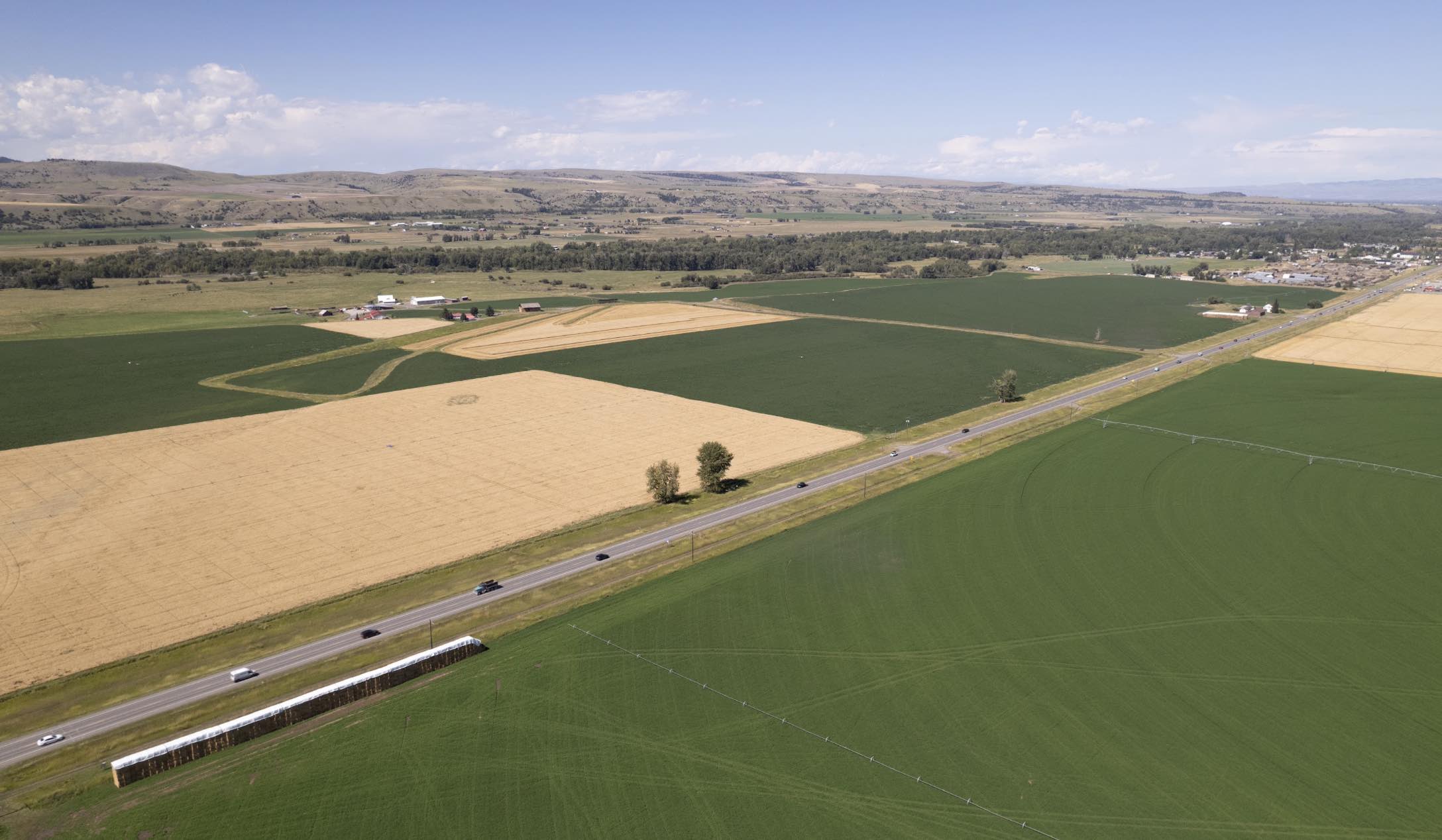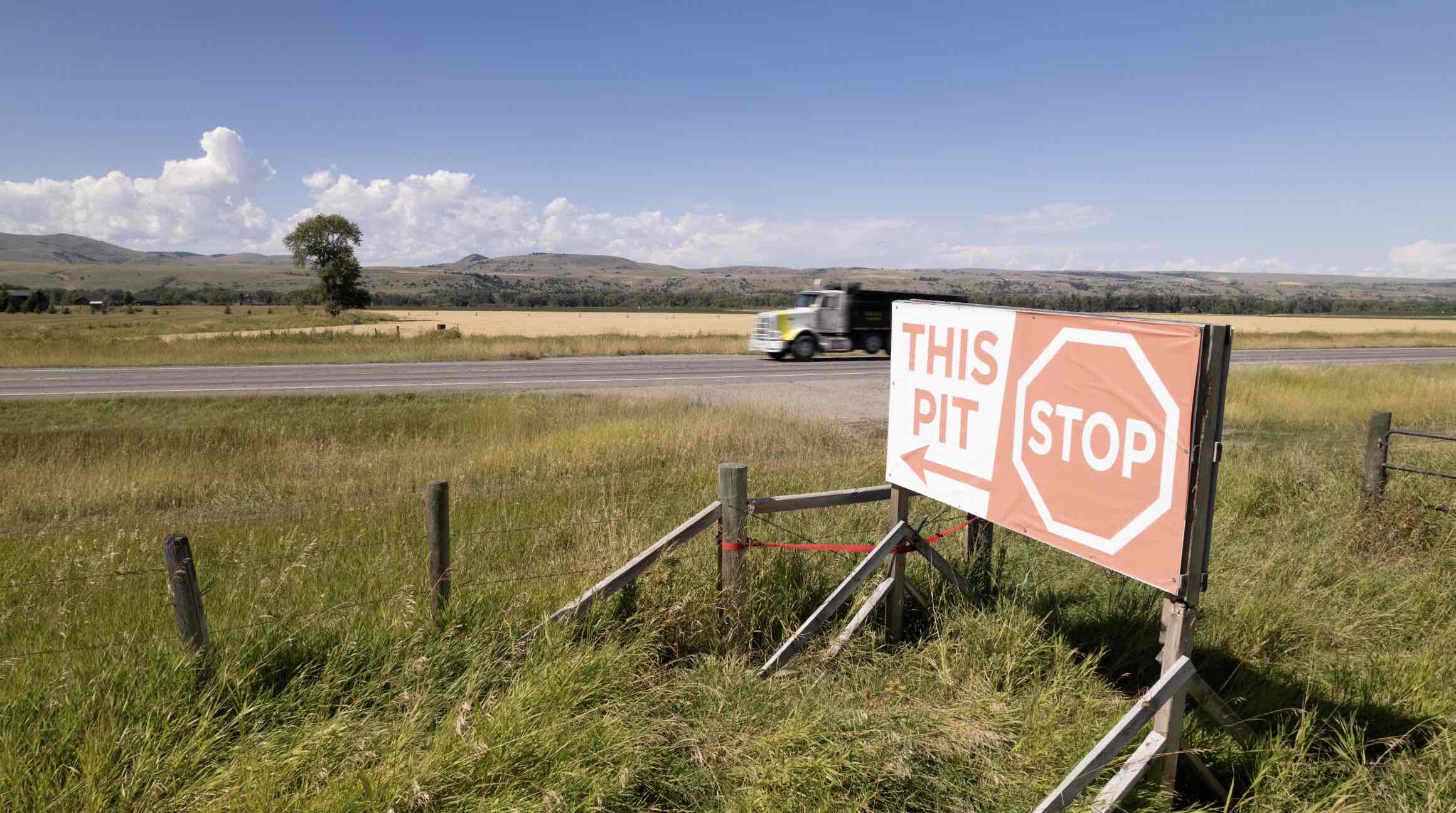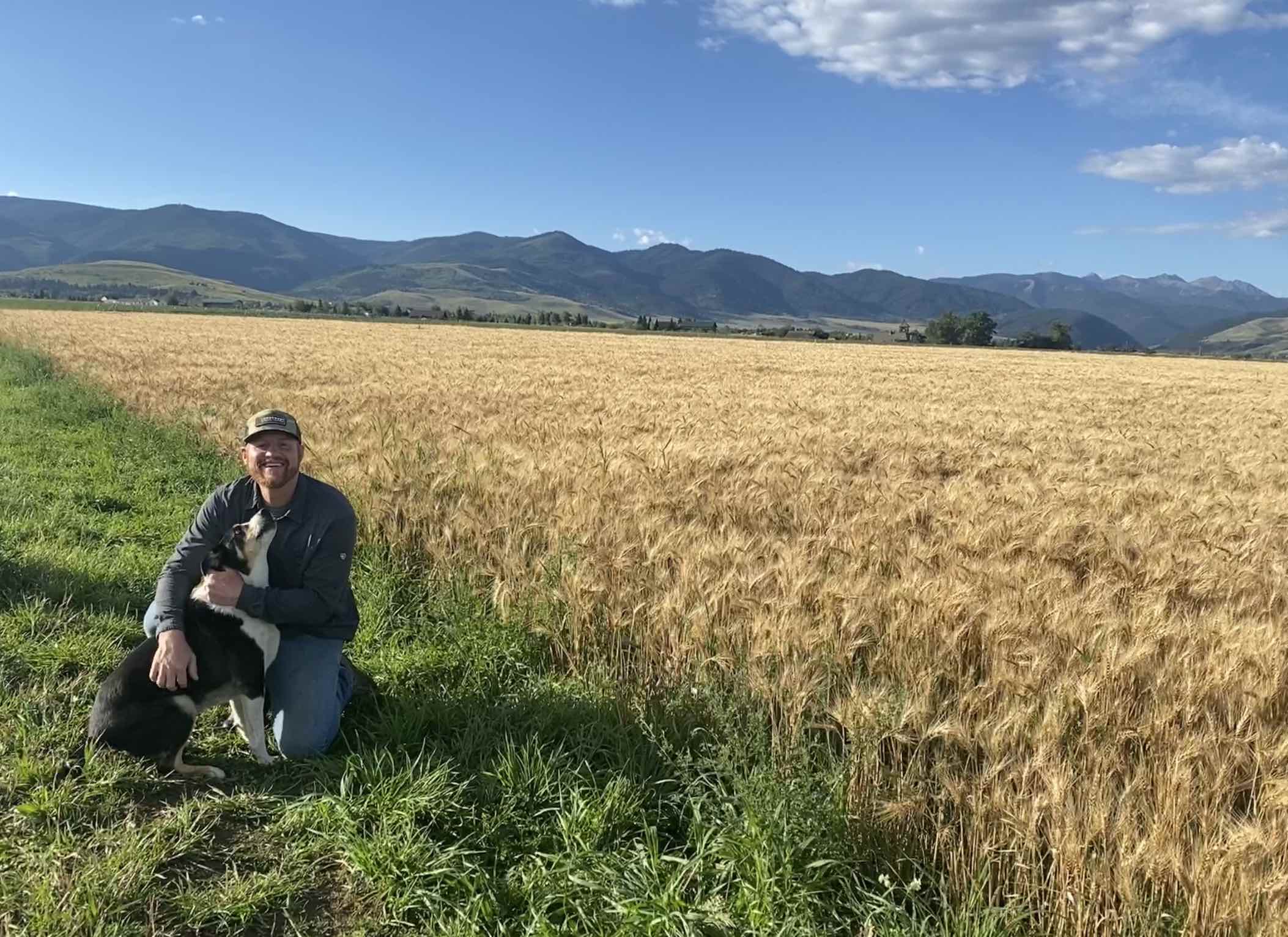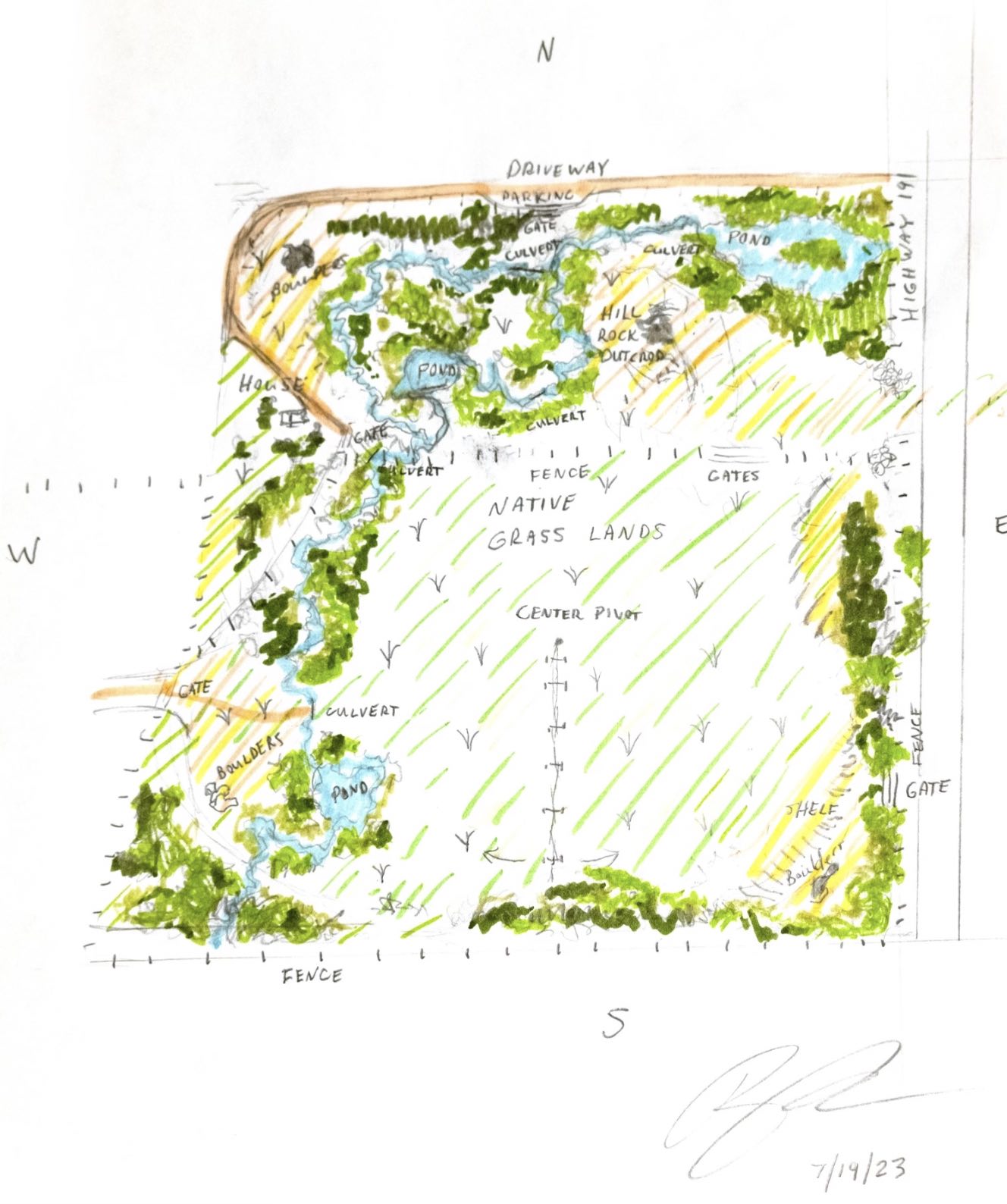In Gallatin Gateway, a gravel pit sparks talk of zoning, growth and the community’s future
By Mira Brody VP MEDIA
Bayard Black reaches down to rub a wheat stalk between his fingers in the field beside his home in Gallatin Gateway. It’s a Roundup-resistant crop on land the Black family leases out, and borders a span of alfalfa, an irrigation ditch and a grass-covered berm with faded tire tracks running down the middle. This 130-acre parcel is just a portion of the land before the mouth of Gallatin Canyon that’s been in his family for five generations.
“Look,” he says, pointing between the tall grass at a group of birds. “Hungarian partridges. ‘Huns,’ I think they call them.”
Despite the mechanic hum of U.S. Highway 191 nearby, the landscape is teeming with wildlife: sandhill cranes peer over tall grasses, the Gallatin River glistens just down the hill, the Spanish Peaks shed morning clouds as the fall day warms. About a mile north is a wooden clock tower marking the heart of the community: a community center, school, post office and gas station.
Gallatin Gateway, an unincorporated community of just over 800, is at the fulcrum of Bozeman and Big Sky’s unyielding growth. Amid the strain, the gravel pit that would sit in the wheat and alfalfa field we’re standing in, is under the magnifying glass.

The pit of the present
The Black Gravel Pit was proposed in May 2023 by TMC Inc., a Belgrade-based sand and gravel company. The proposed 130-acre site would operate in four separate parcels at less than 40-acres each. Each parcel would operate for approximately five years beginning in the summer of 2024. However, the high demand of gravel would make the pit’s lifetime much shorter, explained Ken Stoeber, general manager of TMC.
Black said the pit would consume less than 4% of his property, and override the field of the Monsanto-developed GE wheat, a crop he fears is the cause of his father’s leukemia, and alfalfa, which can cause digestive issues for locally grazing elk. TMC originally approached the Black family in 2016, but the initial pit proposal didn’t pan out due to its proximity to the mouth of the canyon. This location, Black explains, is a better fit, and the income would provide an avenue for his family to keep their property.
“From the money we make we’d be able to invest in the ranch,” Black said. He cites rising property taxes as his latest hurdle. “That’s kind of the thing right now, is as a rancher you’re not ever creating enough income to do things like what your grandfather did. For me it looks like an opportunity to invest back into the property.”
Black took the farm over from his father six years ago, moving back to Montana from a life and business in Minnesota. With his father’s health ailing, Black took up ranching with his children, which he calls a “really holistic, beneficial, healthy lifestyle.”
“I was in love again,” he said.
The Black Gravel Pit would feed development projects across both Madison and Gallatin counties, west Bozeman, throughout Gallatin Canyon including Big Sky and further south along the border of Yellowstone National Park dependent on demand, explained Stoeber in an interview.
It’s a project that has soured neighbors.

Tracie Gibbons, president of the Gateway Conservation Alliance, was one of 30 residents notified of the Black Gravel Pit due to their half-mile proximity from the site. A resident of Hawk Hill Road since 2019, the proposal concerned Gibbons and she gathered the majority signatures in opposition needed to request a public meeting with the Department of Environmental Quality. That meeting took place on July 25.
“The biggest thing is protecting what we know and love about Gallatin Gateway,” Gibbons said in an interview.
The pit motivated her to establish the GCA, a nonprofit that addresses environmental issues impacting the community and brings to light the health and safety concerns the Black Gravel Pit would pose. Some of these, she said, include its proximity to residents and its byproducts including silica dust, noise, traffic and impact on water quality and availability. The safety of her community, she asserted, is at risk.
The GCA hired three lawyers that specialize in land use; Kim Morrison, Rob Farris-Olsen and Graham Coppes; as well as a hydrologist, David Donohue. They’ve organized a Facebook group, fundraising efforts and educational events that reach beyond the gravel pit and addresses Gateway’s future.
“The biggest thing is protecting what we know and love about Gallatin Gateway.”
– Tracie Gibbons, President, Gateway Conservation Alliance
Gibbons said she’s “incredibly disappointed” by her commissioners during the pit proposal process. She feels Gateway has become the “dumping ground and sacrificial lamb” for growth in the area.
“There’s a clear message that we want to keep hammering: the Gallatin Conservation Alliance is not against opencut mines,” Gibbons said. “We’re not against businesses, we’re not against growing the economy. We’re against the opening of this mine because it is close to the community and close to water. We care about the health and safety of people, we understand gravel is a need, but you don’t have to put it in the middle of a community.”
The conflict between the GCA and gravel pit developers is not unique, and the ease at which these projects occur can be traced to a bill that passed during the final hours of the 2021 Montana Legislature.
Zoning Gateway
Montana’s Opencut Mining Act was passed by the 2021 Montana Legislature during their transmittal period, in which legislators quickly pass non-revenue bills. House Bill 599 removed a number of environmental requirements for the establishment of “high and dry” opencut mines. If a mine has no impact on ground or surface water and is away from populated areas, they’ll likely be approved for operation. The purveyor of the bill, Rep. Steve Gunderson, of Libby, Montana, cited the state’s infrastructure needs as his motivation for expediting the mine operation process.
Nick Banish, district manager for the Gallatin Local Water Quality District—the organization that monitors ecologic and hydrologic conditions along a network of around 60 wells and 17 surface water sites across the district—called it a “hurried approach.”
“The legislation and the governor right now, they seem to be taking an approach that maximizes potential development and maximizes things like, let’s provide the goods and services that developers need to get this place modernized and running at full steam,” Banish said in an interview. He was present as a resource at the DEQ’s July 25 meeting.
Although the Opencut Mining Act still requires gravel pits to comply with local zoning laws, Gallatin Gateway is currently un-zoned, a solution the GCA is pushing for.
On Aug. 15, the GCA and the Black family attended a Gallatin County Commission meeting that included an agenda item about the Black Gravel Pit. During that discussion, commissioner Zach Brown recalled “frustration, fear and anger” from pit-opposers. The commission, Brown explained, doesn’t actually have a decision point in the issue, and he emphasized that the process is frustrating by design.
Should the commission implement interim zoning—an emergency measure that can be taken when public health, safety, morals or welfare are at stake—Black’s property would remain unfazed. Although the intent to eventually incorporate the community is a conversation, Brown said, “that takes a long time and that doesn’t address the short-term fires that people are upset about.”
Brown also feels it’s notable that a republican legislation passed the Opencut Mining Act that allows for this and similar projects to take place, a political party Gallatin Gateway residents historically vote in favor of.
“I empathize with those concerns. I think there are real impacts,” Brown said. Born and raised in Gallatin County, Brown said his father lives near a pit and often echoes the complaints Brown has been hearing about this project. “But on the other hand, we all use gravel every day. Every time you drive on a gravel road or street or walk on a sidewalk, you use gravel. It’s the foundation of everyone’s home in Gallatin Gateway.”
“The legislation and the governor right now, they seem to be taking an approach that maximizes potential development and maximizes things like, let’s provide the goods and services that developers need to get this place modernized and running at full steam.”
– Nick Banish, District Manager, Gallatin Local Water Quality District
The long game for the commission is zoning, something Brown has been advocating for since he was elected in January 2021. But the community is divided on that topic, a stance commissioners learned from stakeholder interviews while updating the Gallatin Gateway Community Plan.
“For all the people who have wanted us to zone Gateway yesterday, there’s an equal number of folks who are against zoning,” Brown said. “[The commissioners] think zoning is the best place to provide for the future, but we have to tread thoughtfully and carefully, and a lot of people who are angry with us are making broad assumptions that their opinions are shared by their neighbors.”
In the interim, the pit comes down to HB 599, which the commission does not have the standing to challenge in court. The public however, does.
“People who have standing to challenge the law are those who live in Gallatin Gateway,” Brown said.
Community impacts
“The last thing that canyon needs is more trucks,” said Stoeber, who resides in Gateway.
Anyone who lives in Gateway, or is the one of 9,000 daily commuters, would be hard-pressed to disagree. The singular route between Bozeman and Big Sky, U.S. Highway 191 is dotted with over 100 white crosses marking traffic fatalities in the narrow, busy and weather-prone corridor. Adding more trucks to this route is of high concern for many in the region.
He said the Black Gravel Pit is not going to add any more traffic to this corridor. In fact, he’d be “willing to bet” that there will be fewer trucks on the route since the location allows for shorter round-trips. He also takes pride in TMC’s “safe, up-to-date fleet [of professionals] on the road.”
The proposal requires a northbound left turn lane, as well as a southbound acceleration lane to and from the site, a cost TMC would be responsible for, confirmed Dave Gates, district preconstruction engineer with MDT.
“We met with MDT, we did our traffic study, and the plan we promised exceeded MDT’s recommendation for a turn lane and acceleration lane,” Stoeber explained. He said TMC additionally petitioned for the speed limit to be lowered through Gateway. He also hopes for the option of running trucks at night under special conditions such as highway construction projects, to offset high-impact traffic situations.
Traffic isn’t the only issue raised by opposition. Silica dust, wells and the quality of the neighboring Gallatin River have been penned in comments to the commission and DEQ.
Opencut mining can create dust, some of which may leave the site boundary, the DEQ explained in an email to EBS. Dust from crushing operations are regulated under TMC’s Portable Facility Air Registration through DEQ’s Air Quality program and all opencut mining applications are reviewed by the DEQ to ensure compliance with Montana law, specifically the Opencut Mining Act. Stoeber confirmed that crushing will take place Monday through Friday between the hours of 7 a.m. and 6 p.m. and that dust would be managed with spray bars. The pit will include the construction of berms, an “acceptable Best Management Practice for controlling and directing stormwater,” the DEQ statement explained on this topic.
“The magnitude of a storm that could carry runoff from the proposed site to the Gallatin River approximately 2,500 feet away would be quite significant,” the statement continued.
TMC has mined throughout the Gallatin Valley, Stoeber said, and never impacted a local well. Pending results from two new monitoring wells that help determine the depth of the surrounding water table, he explained, the pit will adhere to a 10-foot buffer from that determined depth, a rule all of their projects follow.
Nick Banish confirmed that the silica levels in the area were “on par with what you’d expect to see” and added that silica is a required component in bioprocesses in river food webs, occurring throughout the Gallatin.
“When I talked to the DEQ I looked at the existing gravel pit well that we have and … nothing seems to leap out off the page to me as far as water quality results,” Banish said, referring to the Morgan Pit a few miles north of the proposed Black Gravel Pit. “Nor was there a substantial decline in water well levels. It looked like regular Gallatin Valley water.”
For Stoeber, it all comes down to the reality of resources.
“We need the resource,” Stoeber said of gravel. “Our community continues to grow so how are we going to manage and feed this growth? How are going to supply the materials needed? The overall growth plan for the county is for 200,000 people, so if the county has forecasted that kind of growth we need to be thinking about where the resources are going to come from.”

The long view
Across the two parcels of land owned by the Blacks—the Bottom Black Ranch, where his house and proposed gravel pit site lies, and Reeseplace closer to the canyon’s mouth where he drives cattle—Bayard Black said he still comes across relics from generations past. There’s a field of old cars and scrap piles of iron from when his grandfather stockpiled materials through the uncertainty of the Great Depression.
“They always had to innovate,” Black said. “You’re always looking for ways to survive.”
This was on his mind as he reviewed TMC’s proposal. Over the 152 years they’ve owned their land, his family has come up with creative ways to keep it. He’s not keen on a federally-funded conservation easement—he says his family has never taken a farm subsidy— and likes the idea of flexibility for future generations as well as workers benefiting from local employment.
“The overall growth plan for the county is for 200,000 people, so if the county has forecasted that kind of growth we need to be thinking about where the resources are going to come from.”
– Ken Stoeber, General Manager, TMC Inc.
Of his opposers, he appreciates their shared love for the land.
“So many people are so passionate, really, I get it,” Black said. “I understand and I don’t have anything against people’s concerns. Most of them are really valid. What I have found is that it seems like people have weaponized these ideas and scared the s*** out of everybody and no one has any actual proof or record of those things happening [in TMC’s projects].”

The Black Gravel Pit proposal includes a reclamation bond of close to $1.4 million, Stoeber said, that would restore the pit’s operation site to an area that matches the native landscape, a vision that also aligns strongly with Black’s. The practice of reclaiming an opencut mine after its lifetime is “pretty common,” Stoeber said; there’s an example of it along Cottonwood Road, where another TMC gravel pit once operated.
Taking a left out of Black’s property back onto 191 toward Bozeman is treacherous task. Commuters, tourists and semi-trucks whizz in either direction, eager to close the gap on their travel time. A row of condos, year-old Yellowstone Club employee housing, obscure the horizon to the east. While rapid population growth is unarguably felt in Bozeman and Big Sky, here it can be witnessed in swift, unstoppable force.
Black sees his land both granularly and long term. A photographer, he captures the things that make Gateway special each day, from a family of grouse, snow-capped Spanish Peaks, a herd of elk grazing in a sea of gold. His ability to see a longer vision is a quality he attributes to his family’s history as ranchers.
“I’m a longterm optimist in life, and in general,” Black said. “There’s still lodgepole posts on corrals that I fix that my grandpa had cut and brought down. I’m benefitting now from what was done 100 years ago.”












